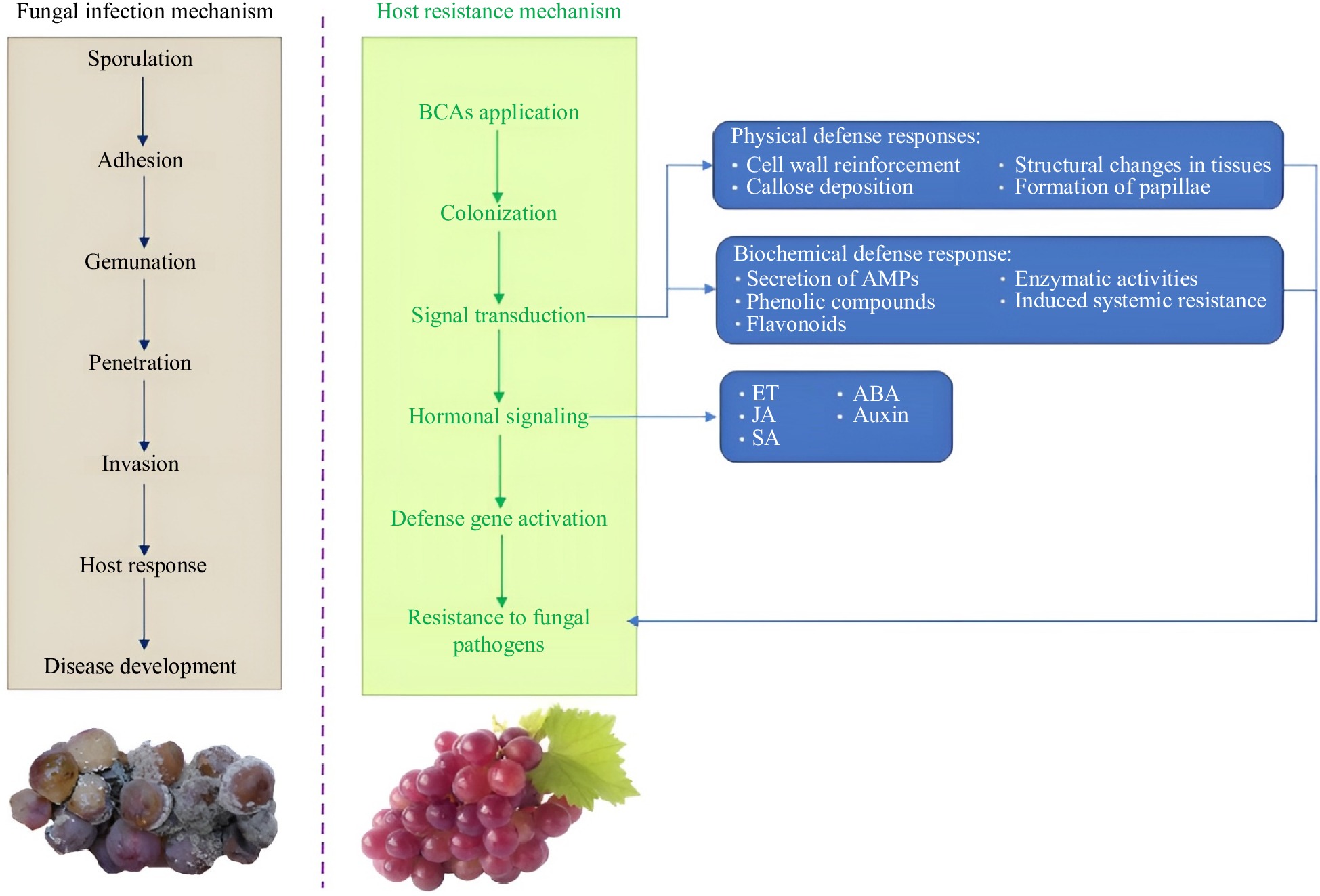-

Figure 1.
Fungal infection mechanism and resistance mechanisms of fruits against fungal pathogens after treatment with BCAs.
-
Chemical structure Mycotoxin Chemical name Molecular formula Molecular
weight (g/mol)Chemical abstracts services (CAS) number Hazard identification Dibenzopyrone derivatives Alternariol (AOH) 3,7,9-trihydroxy-1-methyl-6H-dibenzo[b,d]pyran-6-one C14H10O5 258.226 641-38-3 - AOH, AME, and ALT are less poisonous than other mycotoxins
- At doses of ≥ 1 μM and 25 μM, respectively, AOH and AME markedly enhanced the rate of DNA strand breaks in human colon cancer cellsAlternariol monomethyl ether (AME) 3,7-dihydroxy-9-methoxy-1-methyl-6H-dibenzo[b,d]pyran-6-one C15H12O5 272.253 23452-05-3 Altenuene (ALT) 2α,3α,4aβ-tetrahydro-2,3,7-trihydroxy-9-methoxy-4a-methyl-6H-dibenzo[b,d]pyran-6-one C15H16O6 292.284 29752-43-0 Perylene quinone derivatives Altertoxin I (ATX I) 1,2,7,8,12b-pentahydro-1,4,6b,10-tetrahydroxy-perylene-3,9-dione C20H16O6 352.337 56258-32-3 - Compared to AOH and AME, ATX I, -II, and -III are more powerful mutagens and acute poisons for mice
- ATX-II has high genotoxicity and is the most powerful member of the ATX group with various action mechanismsAltertoxin II (ATX II) [perylo(1,2-b)oxirene-7,11-dione,7a,8a,8b,8c,9,10-hexahydro-1,6,8c-trihydroxy-, (7aR,8aR,8bS,8cR)-] C20H14O6 350.321 56257-59-1 Altertoxin III (ATX III) [perylo(1,2-b:7,8-b’)bisoxirene-5,10-dione, 1a,1b,5a,6a,6b,10a-hexahydro-4,9-dihydroxy-] C20H12O6 348.306 105579-74-6 Tetramic acid derivatives Tenuazonic acid (TeA) 3-acetyl-5-sec-butyl-4-hydroxy-3-pyrrolin-2-one C10H15NO3 197.231 610-88-8 - TeA is more poisonous compared to AOH, AME, and ALT
- By preventing the release of freshly synthesized proteins from the ribosomes, TeA suppresses protein production at the ribosomal level in mammalian cellsTable 1.
The chemical name, molecular formula, molecular weight, CAS number, and hazard identification of major Alternaria toxins.
-
Treatment Target pathogens Target crops Ref. Ascorbic acid + Pichia caribbica Penicillium expansum Apples [64] Chitosan + Pichia anomala Grapes [65] Methyl jasmonate + Meyerozyma guilliermondii Apples [66] Phytic acid + Rhodotorula mucilaginosa Botrytis cinerea Strawberries [67] Sodium bicarbonate + Kloeckera apiculate/Metschnikowia fructicola Cherry fruits [68] Sodium carboxymethyl cellulose + Rhodosporidium paludigenum Alternaria alternata Jujubes [69] Table 2.
Various combination treatments that have been successfully applied in fruit postharvest disease control.
Figures
(1)
Tables
(2)